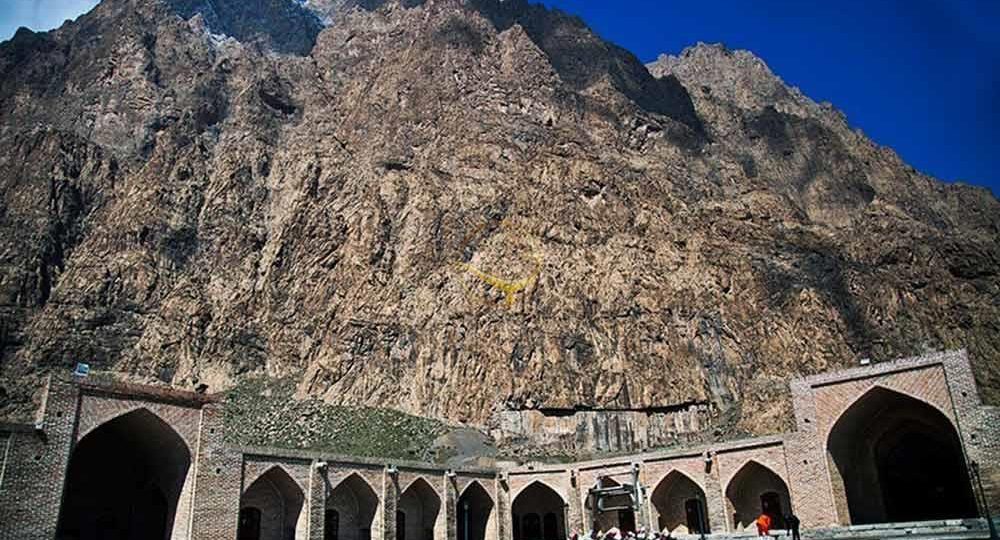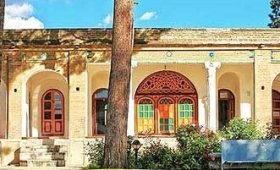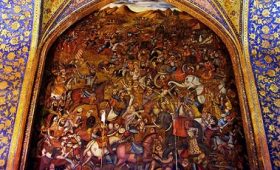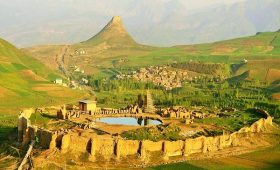Shah Abbasi Caravansarai, Bisotun city is located 30 km east of Kermanshah province. This plain is 1,320 meters above sea level. The exceptional condition of Bisotun mountain has caused many people to call it the gate of Zagros. This city is famous because of the Bisotun mountain and the famous inscription of Darius the Achaemenid. The historical and cultural complex of Bisotun is located in an area of five kilometers in length and three kilometers in width. This collection, with works from the Neolithic period to the Qajar period, has been registered in the UNESCO World Heritage List. Among these works, we can mention Bisotun Caravanserai, which is located on the hillside facing a green and wide plain.
Bisotun Caravanserai, known as Shah Abbasi Caravansarai, is one of the must-see places in Kermanshah and is located 30 kilometers northeast of Kermanshah, in the village of Bisotun Khaneh, in front of Farhad Tarash (the famous relief of Darius on the chest of Bisotun Mountain), in the historical and cultural area of Bisotun. This work has been registered as one of Iran’s national works. Since Bisotun Caravanserai is located almost at the western end of Bisotun historical monuments,
Shah Abbasi Caravansarai was built by order of Shah Abbas I Safavid. According to the inscription left in this building from Shah Suleiman Safavi (1077-1105 AH), it seems that the construction of this caravanserai was completed during the reign of Shah Suleiman and the chancellery of Sheikh Ali Khan Zanganeh. This place was restored by Haji Jafar Khan Mimarbashi Esfhani during the reign of Naseruddin Shah Qajar and Sadrat Mirza Agha Khan Nouri.
The Shah Abbasi Caravansarai is in the style of Chahar Ivani. There are towers in the four corners of this building; The towers on the west side are round and the towers on the east side are octagonal.
The perimeter wall of Shah Abbasi Caravansarai is built from the inside and outside to the floor of the arches with cut stones and from the floor of the arches to the top with bricks. The entrance gate of this caravanserai is 3.50 meters wide on the south side. There are seven arches on each side of this gate. After the gate, you can see a covered space with a transom arch, on the sides of which there are two porches with a crescent arch.
At the beginning of these porches, a staircase has been built to enter the roof. This covered space leads to an octagonal space with a dome arch. On the sides of this octagonal space, there are two porches and each of these porches has three doors. This domed space leads to the Shah Abbasi Caravansarai yard. There are 6 square rooms in each side of the caravanserai. In front of each room, you can see a paved porch. There is also a hexagonal porch in the corner of the yard. On the opposite side of the caravanserai’s entrance, you can see a royal palace. Long stables have also been built behind the caravanserai rooms.
The style Shah Abbasi Caravansarai is in accordance with the architectural pattern of Safavid era caravanserai. Until recent years, this caravanserai was in the hands of the military and police forces, and naturally it had suffered some damages. However, after the Bisotun historical complex was nominated to be registered in the World Heritage List, time was given to the Cultural Heritage Organization. This organization also restored it so that today it is one of the tourist attractions of Kermanshah, welcoming tourists and hosting cultural programs.




